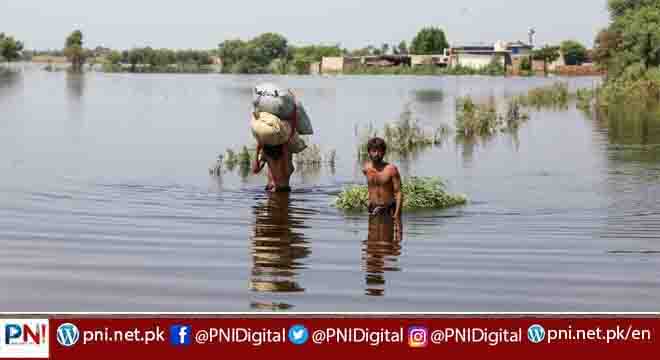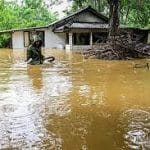UNITED NATIONS, Apr 21 (APP):Floods, droughts and record low ice levels – from the top of the world’s mountains to the depths of the ocean, the climate crisis took a heavy toll as it continued to intensify in 2022, the World Meteorological Organization (WMO), a Geneva-based UN agency, said on Friday
WMO’s latest State of the Global Climate report shows that the last eight years were the eight warmest on record and that sea level rise and ocean warming hit new highs. Record levels of greenhouse gases caused “planetary scale changes on land, in the ocean and in the atmosphere”.
Extensive flooding in Pakistan caused by severe rainfall in July and August last year killed over 1,700 people, while some 33 million were affected, the report said. WMO highlights that total damage and economic losses were assessed at $30 billion and that by October 2022, around 8 million people had been internally displaced by the floods.
The report came a day after an unprecedentedly heavy hailstorm struck Rawalpindi that forced the abandonment of the 4th T20 match between Pakistan and New Zealand.
Released to coincide with this year’s Mother Earth Day, the WMO report echoes UN Secretary-General Antonio Guterres’ call for “deeper, faster emissions cuts to limit global temperature rise to 1.5 degree Celsius”, as well as “massively scaled-up investments in adaptation and resilience, particularly for the most vulnerable countries and communities who have done the least to cause the crisis”.
WMO Secretary-General, Prof. Petteri Taalas, said that amid rising greenhouse gas emissions and a changing climate, “populations worldwide continue to be gravely impacted by extreme weather and climate events”.
He stressed that last year, “continuous drought in East Africa, record-breaking rainfall in Pakistan and record-breaking heatwaves in China and Europe affected tens of millions, drove food insecurity, boosted mass migration, and cost billions of dollars in loss and damage.”
WMO highlights the importance of investing in climate monitoring and early warning systems to help mitigate the humanitarian impacts of extreme weather. The report also points out that today, improved technology makes the transition to renewable energy “cheaper and more accessible than ever”.
The State of the Global Climate report complements the Intergovernmental Panel on Climate Change (IPCC) Sixth Assessment report released a month ago, which includes data up to 2020.
WMO’s new figures show that global temperatures have continued to rise, making the years 2015 to 2022 the eight warmest ever since regular tracking started in 1850. WMO notes that this was despite three consecutive years of a cooling La Niña climate pattern.
WMO says concentrations of the three main greenhouse gases, which trap heat in the atmosphere – carbon dioxide, methane, and nitrous oxide – reached record highs in 2021, which is the latest year for which consolidated data is available, and that there are indications of a continued increase in 2022.
According to the report, “melting of glaciers and sea level rise – which again reached record levels in 2022 – will continue for up to thousands of years”. WMO further highlights that “Antarctic sea ice fell to its lowest extent on record and the melting of some European glaciers was, literally, off the charts”.
Sea level rise, which threatens the existence of coastal communities and sometimes entire countries, has been fueled not only by melting glaciers and ice caps in Greenland and Antarctica but also by the expansion of the volume of oceans due to heat. WMO notes that ocean warming has been “particularly high in the past two decades”.
The report examines the many socio-economic impacts of extreme weather, which have wreaked havoc in the lives of the most vulnerable around the world. Five consecutive years of drought in East Africa, in conjunction with other factors such as armed conflict, have brought devastating food insecurity to 20 million people across the region.
The report also notes that in addition to putting scores of people on the move, throughout the year, hazardous climate and weather-related events “worsened conditions” for many of the 95 million people already living in displacement.
Environmental impacts of climate change are another focus of the report, which highlights a shift in recurring events in nature, “such as when trees blossom, or birds migrate”. The flowering of cherry trees in Japan has been tracked since the ninth century, and in 2021 the date of the event was the earliest recorded in 1,200 years.
As a result of such shifts, entire ecosystems can be upended. WMO notes that spring arrival times of over a hundred European migratory bird species over five decades “show increasing levels of mismatch to other spring events”, such as the moment when trees produce leaves and insects take flight, which are important for bird survival.
The report says these mismatches “are likely to have contributed to population decline in some migrant species, particularly those wintering in sub-Saharan Africa”, and to the ongoing destruction of biodiversity.
In his message on Earth Day, the UN chief warned that “biodiversity is collapsing as one million species teeter on the brink of extinction”, and called on the world to end its “relentless and senseless wars on nature”, insisting that “we have the tools, the knowledge, and the solutions” to address climate change.
Last month, Mr. Guterres convened an Advisory Panel of top UN agency officials, private sector and civil society leaders, to help fast-track a global initiative aiming to protect all countries through life-saving early warning systems by 2027. Stepped-up coordinated action was announced, initially in 30 countries particularly vulnerable to extreme weather, including Small Island Developing States and Least Developed Countries.
WMO Secretary-General Prof. Taalas said Friday that some one hundred countries currently do not have adequate weather services in place and that the UN Early Warnings for All Initiative “aims to fill the existing capacity gap to ensure that every person on earth is covered by early warning services”.
Taalas explained that “achieving this ambitious task requires improvement of observation networks, investments in early warning, hydrological and climate service capacities.” He also stressed the effectiveness of collaboration among UN agencies in addressing the humanitarian impacts of climate events, especially in reducing mortality and economic losses.
Follow the PNI Facebook page for the latest news and updates.








